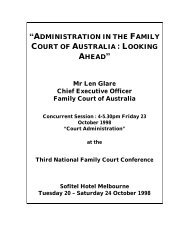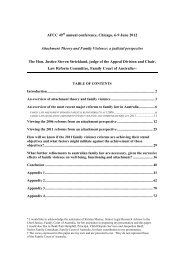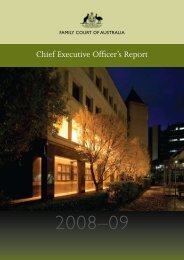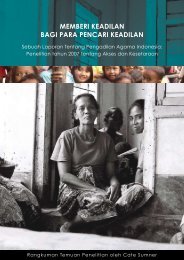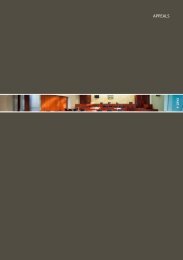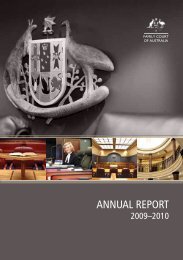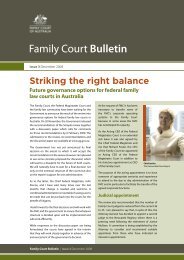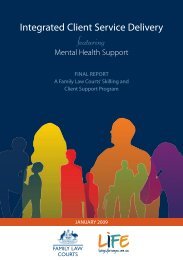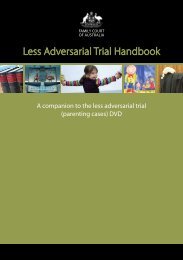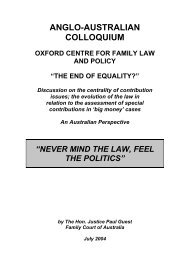Annual report [1997-98] - Family Court of Australia
Annual report [1997-98] - Family Court of Australia
Annual report [1997-98] - Family Court of Australia
Create successful ePaper yourself
Turn your PDF publications into a flip-book with our unique Google optimized e-Paper software.
The <strong>Family</strong> <strong>Court</strong> <strong>of</strong> <strong>Australia</strong> – annual <strong>report</strong> <strong>1997</strong>-<strong>98</strong><br />
served by a steering committee representing the <strong>Court</strong>, the Attorney-General’s Department,<br />
the pr<strong>of</strong>ession and legal aid authorities.<br />
The <strong>report</strong> made a number <strong>of</strong> recommendations, some <strong>of</strong> which were put in place shortly<br />
after its completion. Several others were awaiting my final consideration at the time the<br />
<strong>Court</strong> embarked on a major strategic planning exercise just after the end <strong>of</strong> the financial<br />
year. Early feedback from this project suggested to me that the case management guidelines<br />
required re-visiting and that the evaluation <strong>report</strong> would be affected by such an exercise.<br />
As a consequence the remaining recommendations will be re-considered when these issues<br />
are brought together for the purposes <strong>of</strong> future planning.<br />
Primary Dispute Resolution (PDR)<br />
During the previous financial year the Attorney-General foreshadowed his intention to<br />
review the provision <strong>of</strong> counselling and mediation services within the <strong>Court</strong>. A<br />
Departmental discussion paper, ‘Delivery <strong>of</strong> PDR Services in <strong>Family</strong> Law’, was subsequently<br />
tabled. The <strong>Court</strong> responded to this by way <strong>of</strong> a major submission which was forwarded<br />
to the Attorney-General in late <strong>1997</strong> and was also widely circulated to interested<br />
organisations and individuals.<br />
The submission canvassed the various options available to the Government in considering<br />
issues <strong>of</strong> coverage and possible overlap <strong>of</strong> service delivery. It stressed the importance <strong>of</strong><br />
maintaining primary dispute resolution within the <strong>Family</strong> <strong>Court</strong> as a diversion from litigation,<br />
reiterated the high settlement figures obtained, particularly at the voluntary level, and<br />
noted that attention needed to be given to issues such as security, the pr<strong>of</strong>essional expertise<br />
developed by <strong>Court</strong> counsellors and mediators and the extent to which legal practitioners<br />
and others are confident in referring customers to them.<br />
The <strong>Court</strong> argued that were PDR services to be made less accessible to customers – for<br />
example, if the existing counselling and mediation services were reduced or removed –<br />
opportunities for litigation would increase. This would result in additional family distress<br />
(particularly in children’s matters) and more private and public costs.<br />
This concern proved to be correct. Charges for voluntary counselling and mediation were<br />
imposed in mid-<strong>1997</strong> and the Senate disallowed the legislation five months later. During<br />
the period in which the <strong>Court</strong> was required to collect these charges the counselling customer<br />
base decreased by 10% and the numbers <strong>of</strong> post-filing cases increased by approximately<br />
25%. Such an increase in the numbers <strong>of</strong> people entering the litigation pathway carries<br />
with it an attendant risk that more cases will proceed to trial.<br />
I have for some time been concerned that the <strong>Court</strong>’s narrow definition <strong>of</strong> ‘mediation’and<br />
broad use <strong>of</strong> ‘counselling’fail to describe accurately the services it provides. Both here and<br />
overseas ‘mediation’is used as an all embracing term, which includes a number <strong>of</strong> processes<br />
ranging from the purist non-directive model to dispute resolution which falls short <strong>of</strong> litigation.<br />
‘Counselling’is a rarely used term and ‘conciliation counselling’is also not commonly<br />
understood. The historical rationale for the <strong>Court</strong>’s adherence to the purist view was<br />
to minimise confusion between the services provided by its conciliators and mediators.<br />
There is some evidence to suggest that customers are confused by the nature <strong>of</strong> the differ-<br />
19


![Annual report [1997-98] - Family Court of Australia](https://img.yumpu.com/37244799/24/500x640/annual-report-1997-98-family-court-of-australia.jpg)
